A Seismic Risk Assessment of Concrete-Filled Double-Skin Steel Tube (CFDST) Frames with a Beam-Only-Connection for Reinforced Concrete Shear Walls (BRWs)
Abstract
:1. Introduction
2. Cyclic Tests and Performance Limits
- (1)
- Stage I: from 0 to 1% drift. The CFDST frame-BRW structure can be approximately considered to be in the elastic stage. Although the BRW has small cracks, the deformation has little effect on their structural performance.
- (2)
- Stage II: from 1 to 3% drift. Many obvious cracks appeared on the BRW, and the bolt connection between the BRW and CFDST frame was damaged to a certain extent. Local buckling of column and beam flanges of the CFDST frames was obvious, and the weld connections and flange plates near the high-strength bolts were torn.
- (3)
- Stage III: from 3 to 6% drift. The BRW was obviously deformed, and it had basically separated from the CFDST frame and lost its loading capacity. The steel beam plate and high-strength bolts near the CFDST column were torn, and the CFDST frame joints and the bottom of the column formed a plastic hinge, which has basically lost its loading capacity.
- (1)
- Immediate Occupancy (IO): the structure needs to be used immediately after the earthquake. This stage is described for the CFDST frame-BRW structure, i.e., the BRW has small cracks, the steel beam flange or web exhibits a slight yield or buckling phenomenon, and no obvious fracture phenomenon is observed. The performance limit is defined as 1.0%.
- (2)
- Structural Damage (SD): the structural or nonstructural components may be seriously damaged or partially collapsed, but the building still has a certain ability to resist collapse, which can ensure that the structure will not collapse. For the CFDST frame-BRW structure, this stage is described as follows. The BRW has many cracks, and the concrete at the bolt connection between the BRW and CFDST frame exhibits spalling phenomena. There are many steel plates yielding, buckling, or fracturing on the steel beam near the column, but they do not completely fail, and some members have obvious local buckling or plastic hinges. The performance limit is defined as 3.0%.
- (3)
- Structural Damage (SD): the structure collapses due to its inability to withstand its own gravity or insufficient lateral stiffness. For the CFDST frame-BRW structure, this stage is described as follows. The BRW has basically separated from the CFDST frame and has lost its loading capacity. The steel beam plate in the CFDST frame is torn, the joint concrete is crushed, and the outer steel tube is severely buckled. The performance limit is defined as 6.0%.
3. Numerical Model and Validation
3.1. CFDST Framework Numerical Model and Verification
3.1.1. CFDT Column, Steel Beam, and CFDST Joints
3.1.2. Panel Zone
3.2. CFDST Frame-BRW Structure Numerical Model and Verification
- (1)
- Point A is defined as follows, i.e., the loading capacity Py of the BRW is 0.59 times the peak loading capacity Pu1 of the BRW. The SDR is 0.6%, that is, the displacement is 9.0 mm.
- (2)
- Point B is defined as follows, i.e., the peak loading capacity Pu1 of the BRW is calculated according to the simplified calculation method. The SDR of the BRW is 1.3%, and the displacement is 19.5 mm.
- (3)
- Point C is defined as follows, i.e., the loading capacity Pu2 of the BRW is 0.75 times (BF-BRW-1) and 0.85 times (BF-BRW-2) of the peak loading capacity Pu1 of the BRW, and the SDRs are 2.6% (BF-BRW-1) and 3.3% (BF-BRW-2), that is, the displacements are 39.0 mm (BF-BRW-1) and 49.5 mm (BF-BRW-2), respectively.
- (4)
- Point D is defined as follows, i.e., the loading capacity Pm of the BRW is 0.27 times that of the peak loading capacity Pu1 of the BRW. The SDR is 5.7%, that is, the displacement is 85.5 mm.
4. CFDST Frame-BRW for Seismic Risk Assessment
5. Earthquake Ground Motions
6. Seismic Risk Assessment of CFDST-BRW Structure
6.1. Prototype Structures
6.2. Probabilistic Seismic Demands
6.3. Probabilistic Seismic Demands
6.4. Probability Estimation of Annual Performance Limits
7. Conclusions
- Based on the unified theory, the model considered the mechanical properties of concrete materials under a three-dimensional stress state under compression. A simplified analysis model of a shear wall with beam-end connections of different types of materials was established. The hysteretic characteristics of a BRW under earthquake action were simulated by two nonlinear springs with Pinching04 material properties. The correctness of the adopted simplified analysis model was verified by the seismic performance test results of two CFDST frame-BRW structures.
- A numerical analysis model of a nine-story CFDST frame-BRW structure was established, and ground motion records were selected from the SAC project to describe the seismic risks in the Los Angeles area of the US States, which were divided into two risk levels of 2%/50 years and 10%/50 years. This model uses nonlinear time history analysis and incremental dynamic analysis on the selected records.
- The analysis model’s fragility curves were established using three determined performance limits and structural responses. The annual probability of these three limits and the probability of collapse within 50 years were determined by convoluting the fragility with the seismic risk specified by the USGS.
- The BRW reduced the probability of collapse of the CFDST frame to 2.76% in 50 years, which indicates the proposed BRW could effectively reduce the probability of different degrees of damage in the service cycle of the structure.
Author Contributions
Funding
Data Availability Statement
Acknowledgments
Conflicts of Interest
References
- Wang, X.D.; Gao, P.; Liu, J.P.; Zhao, Q.R.; Xu, H.M.; Wei, W.; Wang, X.T. Assessment on seismic performance of circular concrete-filled thin-walled steel tube columns. Adv. Struct. Eng. 2023, 26, 399–412. [Google Scholar] [CrossRef]
- Skalomenos, K.A.; Hatzigeorgiou, G.D.; Beskos, D.E. Application of the hybrid force/displacement (HFD) seismic design method to composite steel/concrete plane frames. J. Constr. Steel. Res. 2015, 115, 179–190. [Google Scholar] [CrossRef]
- Gan, D.; Zhou, Z.; Yan, F.; Zhou, X.H. Shear transfer capacity of composite sections in steel tubed-reinforced-concrete frames. Structures 2017, 12, 54–63. [Google Scholar] [CrossRef]
- Lai, Z.C.; Huang, Z.H.; Varma, A.H. Seismic analysis and performance of high strength composite special moment frames (C-SMFs). Structures 2017, 9, 165–178. [Google Scholar] [CrossRef]
- Wang, K.; Yuan, S.F.; Chen, Z.X.; Zhi, H.X.; Shi, G.L.; Cao, D.F. Experimental study on hysteretic behavior of composite frames with concrete-encased CFST columns. J. Constr. Steel. Res. 2016, 123, 110–120. [Google Scholar] [CrossRef]
- Bai, Y.T.; Hu, H.S.; Wang, J.T.; Sun, Q. Modeling on collapse behaviour of high-rise concrete-filled steel composite frames under over-design seismic excitations. Struct. Infrastruct. Eng. 2017, 13, 1563–1575. [Google Scholar] [CrossRef]
- Ren, F.M.; Zhou, Y.; Zhang, J.B.; Lin, S.M. Experimental study on seismic performance of CFST frame structures with energy dissipation devices. J. Constr. Steel. Res. 2013, 90, 120–132. [Google Scholar] [CrossRef]
- Jia, M.M.; Lu, D.G.; Guo, L.H.; Sun, L. Experimental research and cyclic behavior of buckling-restrained braced composite frame. J. Constr. Steel. Res. 2014, 95, 90–105. [Google Scholar] [CrossRef]
- Nie, J.G.; Hu, H.S.; Fan, J.S.; Tao, M.X.; Li, S.Y.; Liu, F.J. Experimental study on seismic behavior of high-strength concrete filled double-steel-plate composite walls. J. Constr. Steel. Res. 2013, 88, 206–219. [Google Scholar] [CrossRef]
- Wang, J.F.; Li, B.B. Cyclic testing of square CFST frames with ALC panel or block walls. J. Constr. Steel. Res. 2017, 130, 264–279. [Google Scholar] [CrossRef]
- Guo, L.H.; Rong, Q.; Qu, B.; Liu, J.P. Testing of steel plate shear walls with composite columns and infill plates connected to beams only. Eng. Struct. 2017, 136, 165–179. [Google Scholar] [CrossRef]
- Hu, Y.; Zhao, J.H.; Zhang, D.F.; Li, Y.P. Cyclic performance of concrete-filled double-skin steel tube frames strengthened with beam-only-connected composite steel plate shear walls. J. Build. Eng. 2020, 31, 15. [Google Scholar] [CrossRef]
- Bian, J.L.; Cao, W.L.; Dong, H.Y.; Chen, J.W. Seismic research of prefabricated CFST frame with various H-steel frame shear walls. J. Build. Eng. 2022, 57, 20. [Google Scholar] [CrossRef]
- Hu, Y.; Zhao, J.H.; Zhang, D.F.; Zhang, H.Q. Cyclic tests of fully prefabricated concrete-filled double-skin steel tube/moment-resisting frames with beam-only-connected steel plate shear walls. Thin-Walled Struct. 2020, 146, 14. [Google Scholar] [CrossRef]
- Xu, S.Y.; Li, Z.L.; Liu, H.J. Global seismic performance of a new precast CFST column to RC beam braced frame: Shake table test and numerical study. Steel Compos. Struct. 2016, 21, 805–827. [Google Scholar] [CrossRef]
- Skalomenos, K.A.; Hatzigeorgiou, G.D.; Beskos, D.E. Modeling level selection for seismic analysis of concrete-filled steel tube/moment-resisting frames by using fragility curves. Earthq. Eng. Struct. Dyn. 2015, 44, 199–220. [Google Scholar] [CrossRef]
- Leon, R.T.; Gao, Y. Resiliency of steel and composite structures. Front. Struct. Civ. Eng. 2016, 10, 239–253. [Google Scholar] [CrossRef]
- Kamaris, G.S.; Skalomenos, K.A.; Hatzigeorgiou, G.D.; Beskos, D.E. Seismic damage estimation of in-plane regular steel/concrete composite moment resisting frames. Eng. Struct. 2016, 115, 67–77. [Google Scholar] [CrossRef]
- Ahmadi, M.; Naderpour, H.; Kheyroddin, A.; Gandomi, A.H. Seismic failure probability and vulnerability assessment of steel-concrete composite structures. Period. Polytech.-Civ. Eng. 2017, 61, 939–950. [Google Scholar] [CrossRef]
- Hu, Y.; Zhao, J.H.; Zhang, D.F.; Zhang, Y.F. Seismic risk assessment of concrete-filled double-skin steel tube/moment-resisting frames. Earthq. Struct. 2018, 14, 249–259. [Google Scholar] [CrossRef]
- FEMA. FEMA 356 Prestandard and Commentary for the Seismic Rehabilitation of Buildings; FEMA: Washington, DC, USA, 2000.
- HAZUS. HAZUS Earthquake Loss Estimation Methodology. National Institute of Building for the FEMA; HAZUS: Washington, DC, USA, 1997. [Google Scholar]
- SEAOC. SEAOC Appendix I: Tentative Guidelines for Performance-Based Seismic Engineering; SEAOC: Sacramento, CA, USA, 1999. [Google Scholar]
- Ibarra, L.F.; Medina, R.A.; Krawinkler, H. Hysteretic models that incorporate strength and stiffness deterioration. Earthq. Eng. Struct. Dyn. 2005, 34, 1489–1511. [Google Scholar] [CrossRef]
- Muhummud, T. Seismic Behavior and Design of Composite SMRFs with Concrete Filled Steel Tubular Columns and Steel Wide Flange Beams. Ph.D. Dissertation, Lehigh University, Bethlehem, PA, USA, 2023. [Google Scholar]
- Lignos, D.G.; Krawinkler, H. Deterioration modeling of steel components in support of collapse prediction of steel moment frames under earthquake loading. J. Struct. Eng. 2011, 137, 1291–1302. [Google Scholar] [CrossRef]
- Ellingwood, B.R.; Kinali, K. Quantifying and communicating uncertainty in seismic risk assessment. Struct. Saf. 2009, 31, 179–187. [Google Scholar] [CrossRef]
- Soni, D.P.; Mistry, B.B.; Jangid, R.S.; Panchal, V.R. Seismic response of the double variable frequency pendulum isolator. Struct. Control Health Monit. 2011, 18, 450–470. [Google Scholar] [CrossRef]
- Dolsek, M. Simplified method for seismic risk assessment of buildings with consideration of aleatory and epistemic uncertainty. Struct. Infrastruct. Eng. 2012, 8, 939–953. [Google Scholar] [CrossRef]
- Tubaldi, E.; Barbato, M.; Ghazizadeh, S. A probabilistic performance-based risk assessment approach for seismic pounding with efficient application to linear systems. Struct. Saf. 2012, 36–37, 14–22. [Google Scholar] [CrossRef]
- Tubaldi, E.; Barbato, M.; Dall'Asta, A. Performance-based seismic risk assessment for buildings equipped with linear and nonlinear viscous dampers. Eng. Struct. 2014, 78, 90–99. [Google Scholar] [CrossRef]
- Kosic, M.; Fajfar, P.; Dolsek, M. Approximate seismic risk assessment of building structures with explicit consideration of uncertainties. Earthq. Eng. Struct. Dyn. 2014, 43, 1483–1502. [Google Scholar] [CrossRef]
- Asgarian, B.; Ordoubadi, B. Effects of structural uncertainties on seismic performance of steel moment resisting frames. J. Constr. Steel. Res. 2016, 120, 132–142. [Google Scholar] [CrossRef]
- Melani, A.; Khare, R.K.; Dhakal, R.P.; Mander, J.B. Seismic risk assessment of low rise RC frame structure. Structures 2016, 5, 13–22. [Google Scholar] [CrossRef]
- Kechidi, S.; Macedo, L.; Castro, J.M.; Bourahla, N. Seismic risk assessment of cold-formed steel shear wall systems. J. Constr. Steel. Res. 2017, 138, 565–579. [Google Scholar] [CrossRef]
- Jalayer, F.; Ebrahimian, H. Seismic risk assessment considering cumulative damage due to aftershocks. Earthq. Eng. Struct. Dyn. 2017, 46, 369–389. [Google Scholar] [CrossRef]
- Aghababaei, M.; Mahsuli, M. Component damage models for detailed seismic risk analysis using structural reliability methods. Struct. Saf. 2019, 76, 108–122. [Google Scholar] [CrossRef]
- Lu, D.G.; Yu, X.H.; Jia, M.M.; Wang, G.Y. Seismic risk assessment for a reinforced concrete frame designed according to Chinese codes. Struct. Infrastruct. Eng. 2014, 10, 1295–1310. [Google Scholar] [CrossRef]


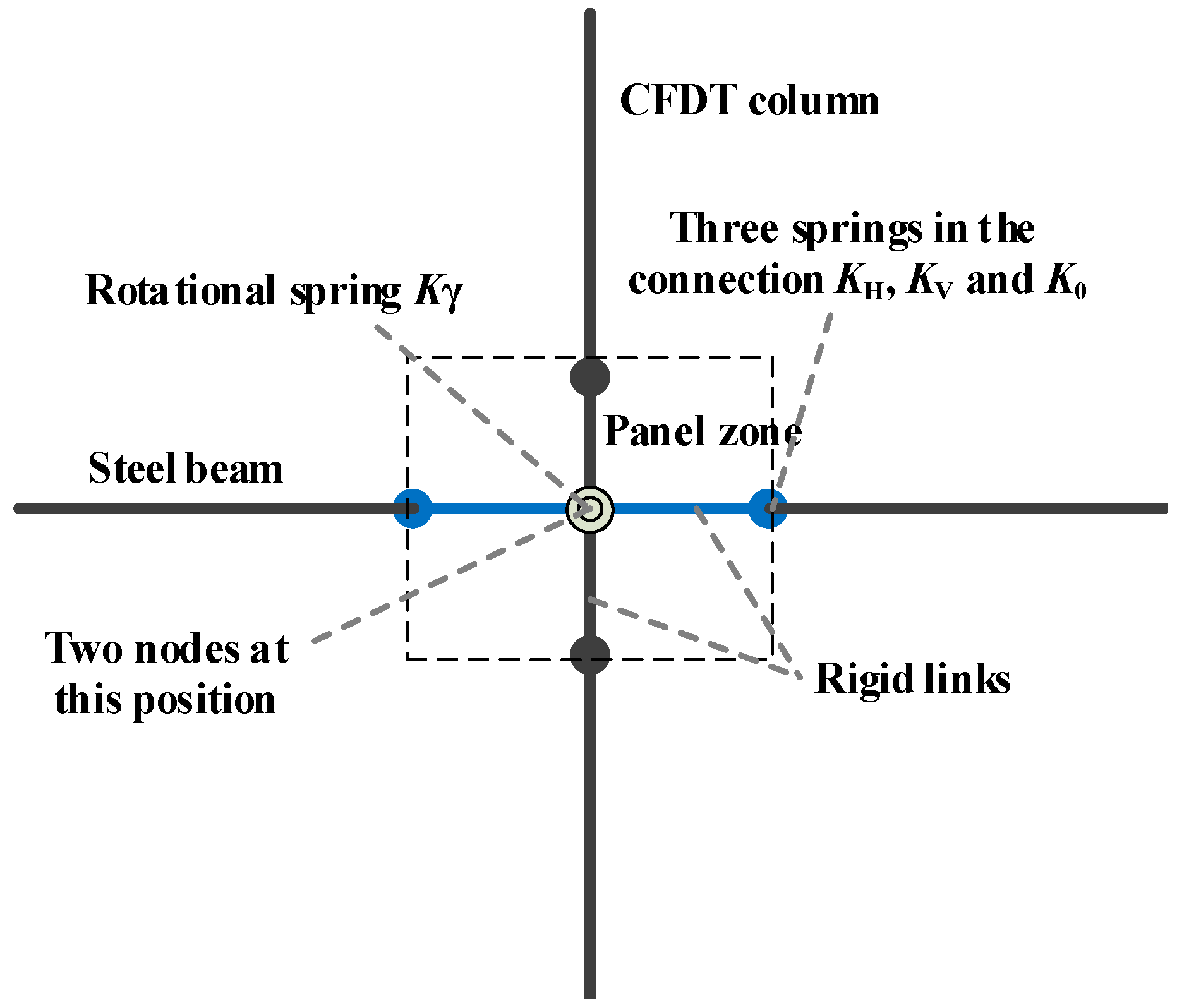
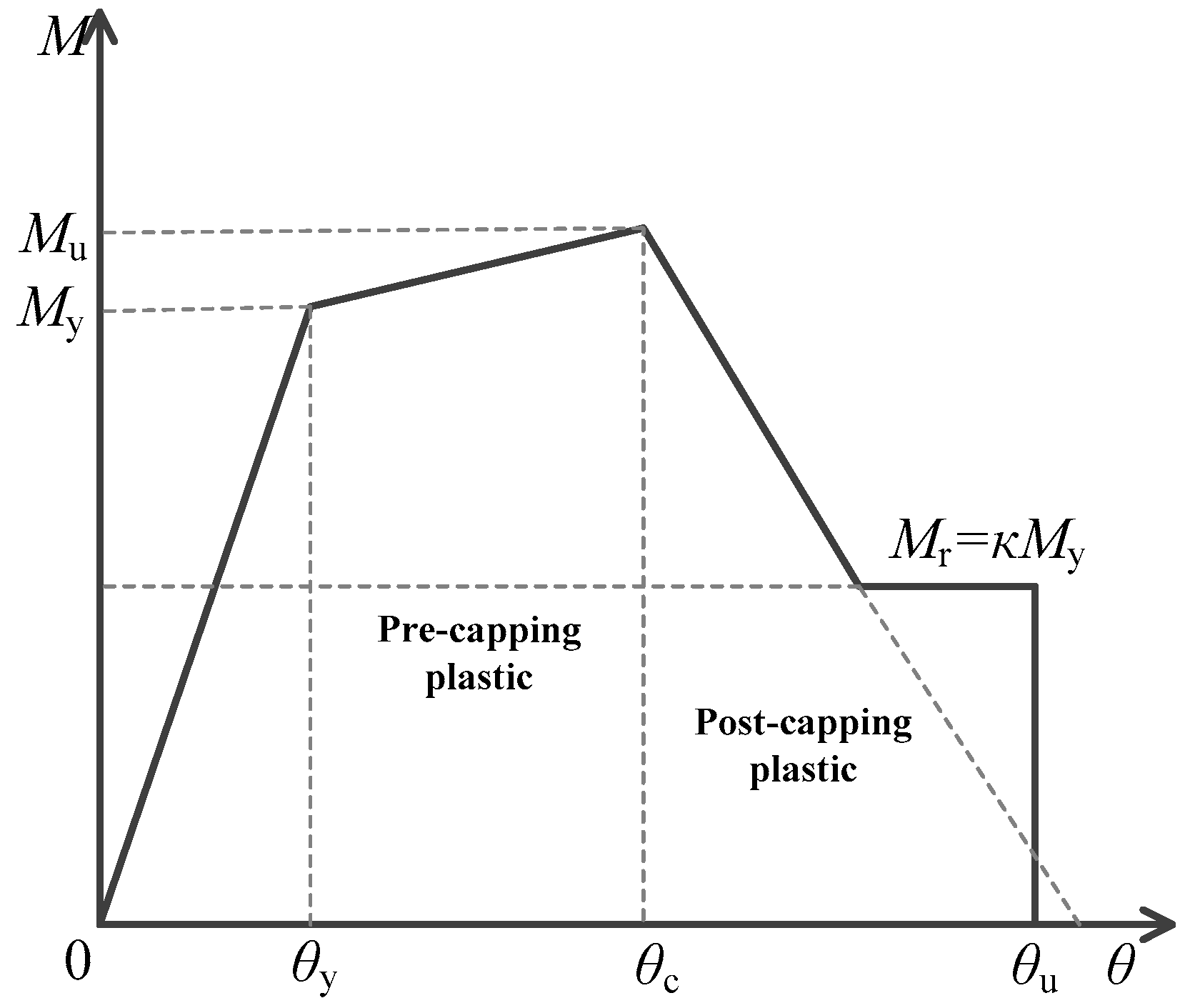
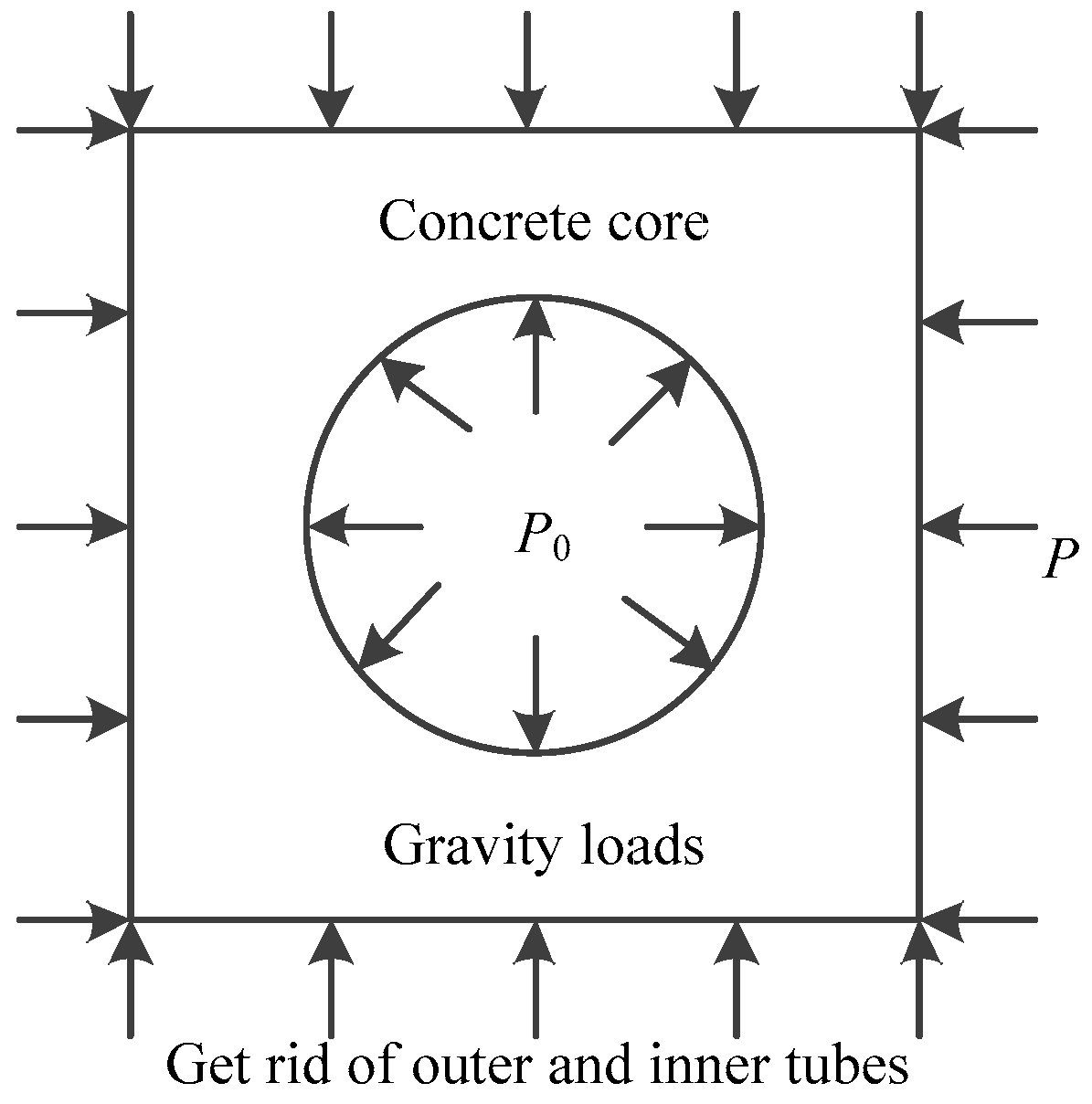

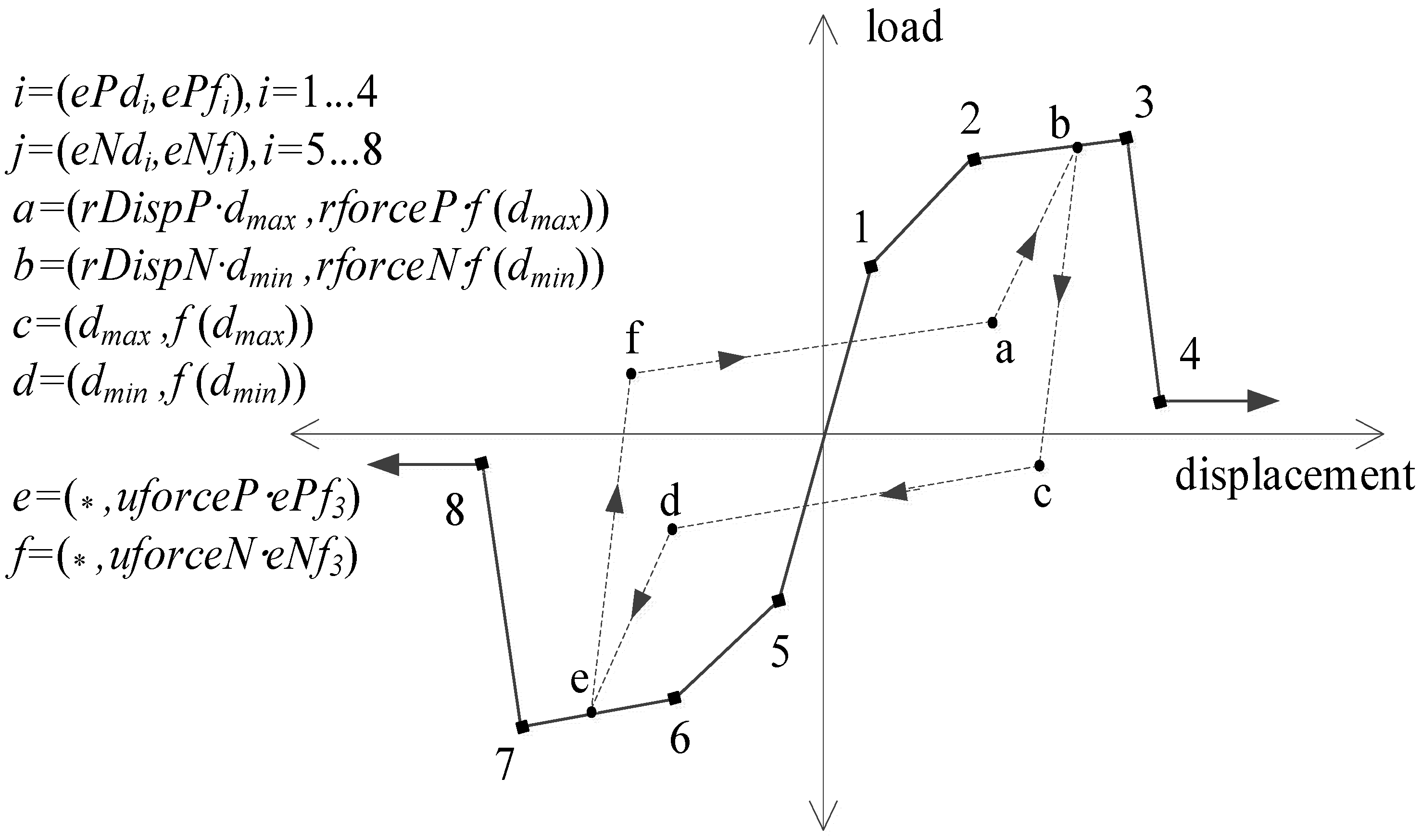
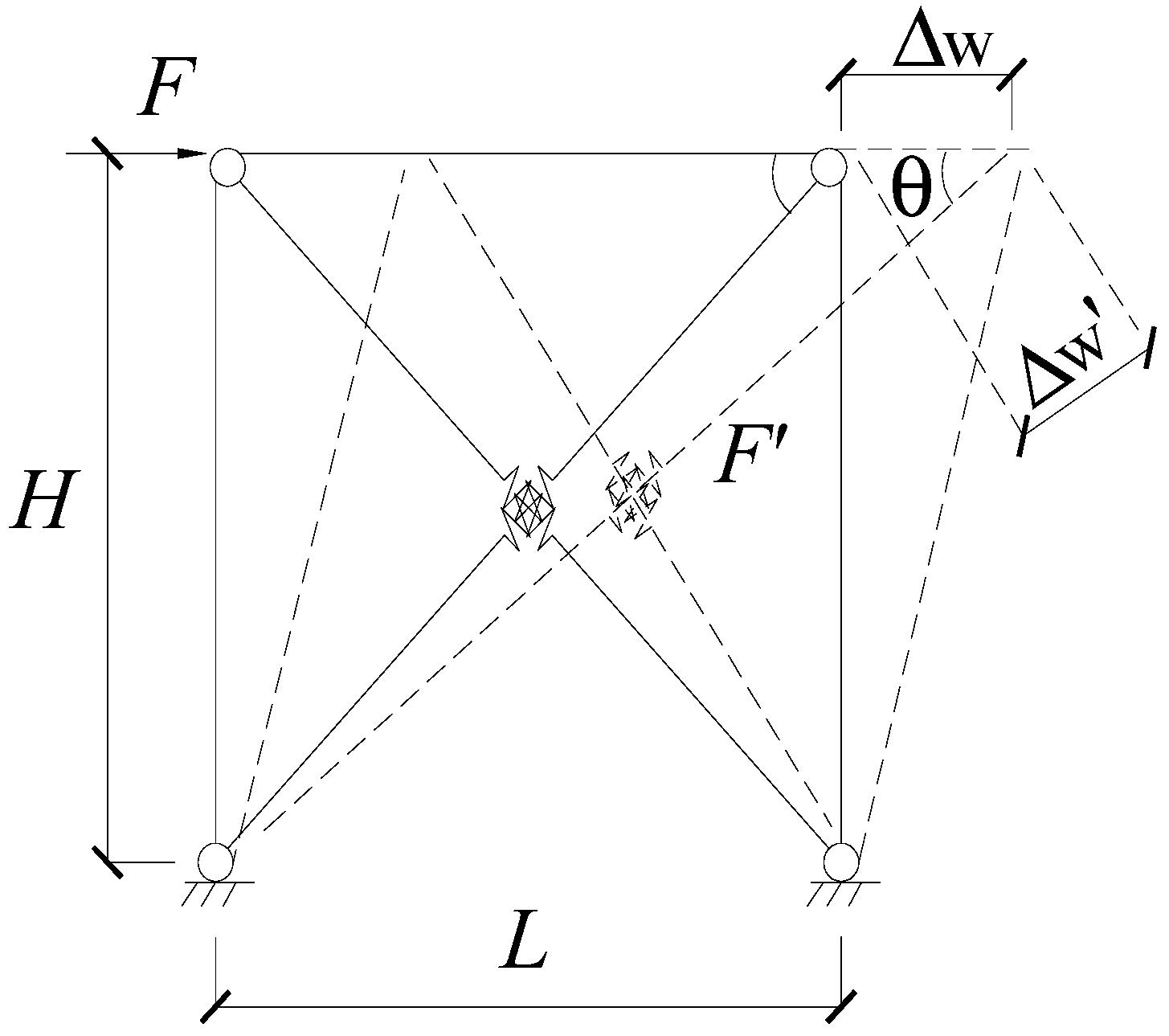
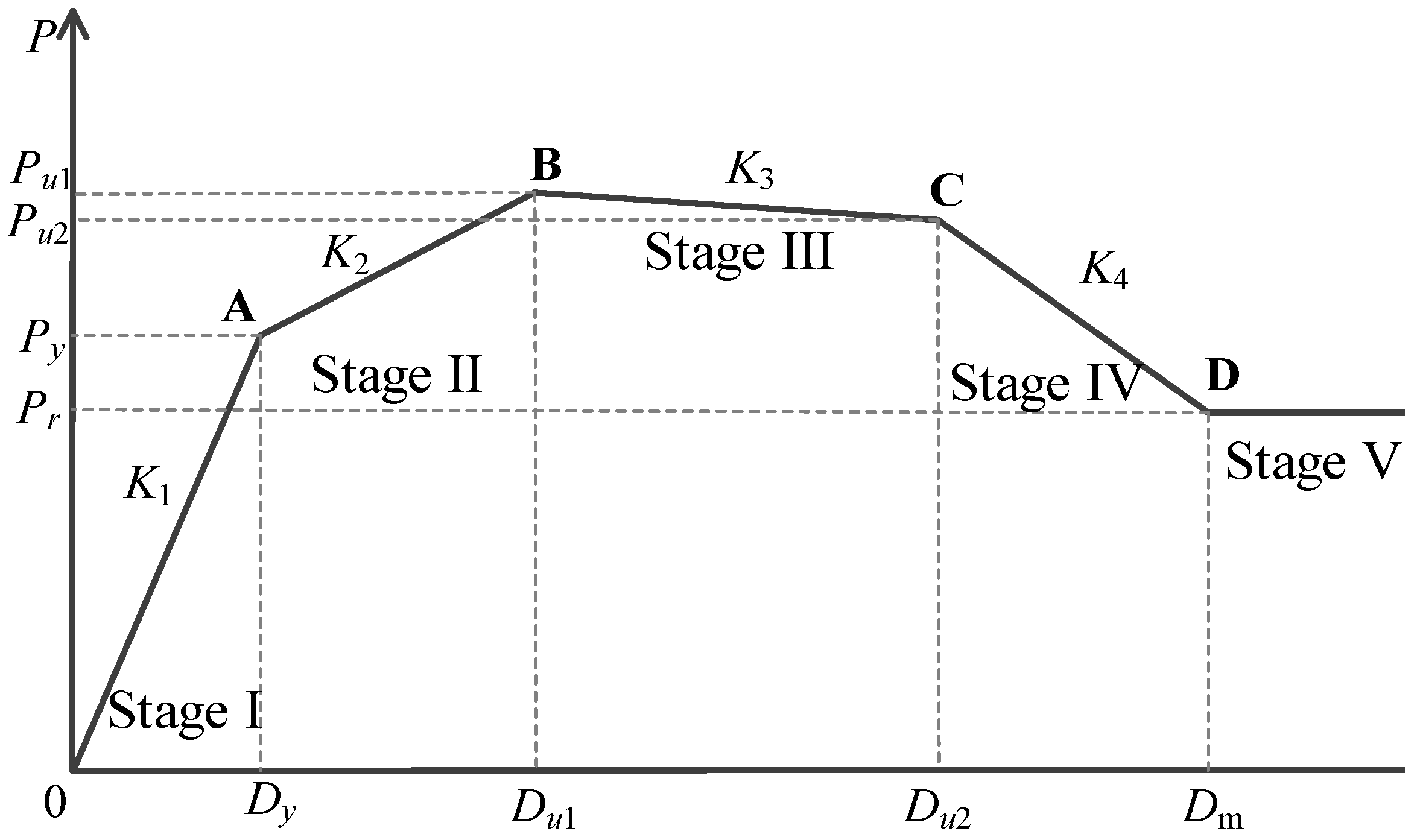
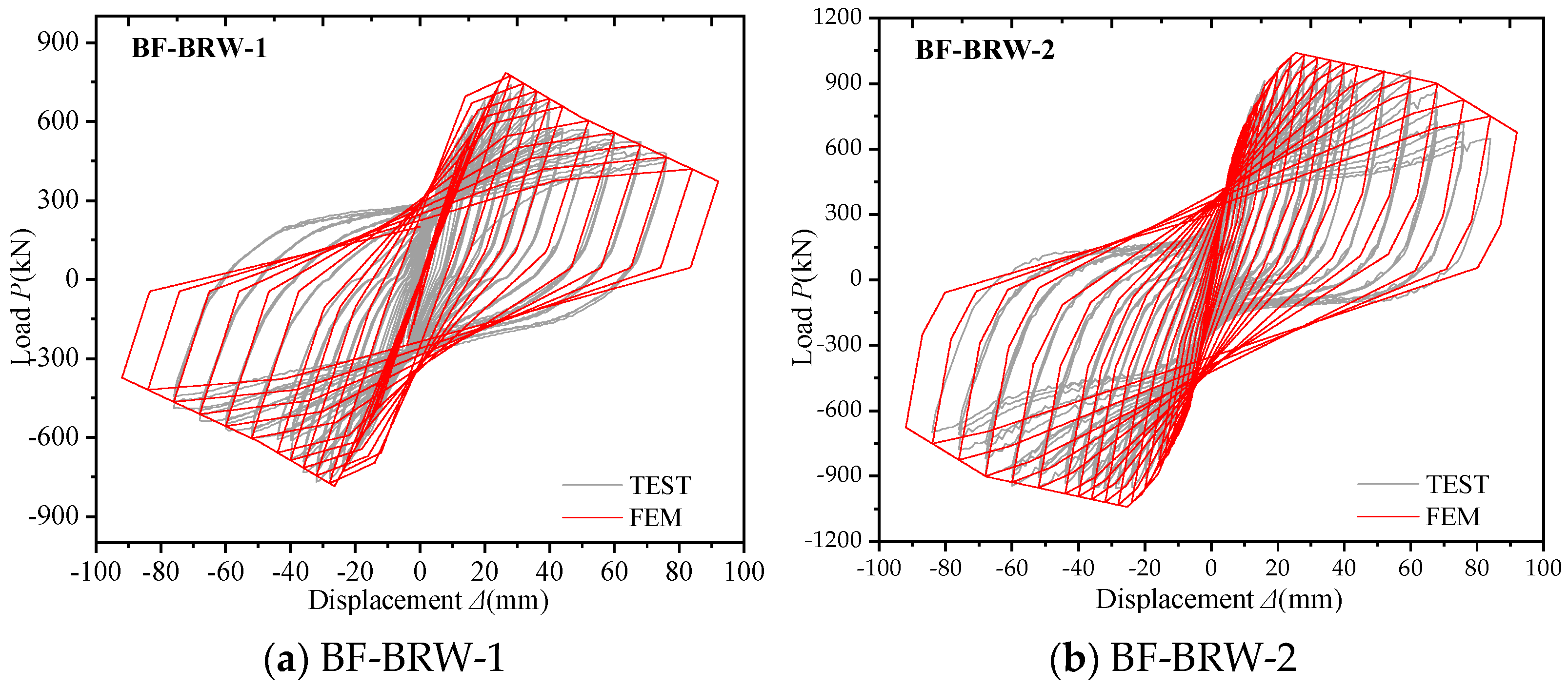
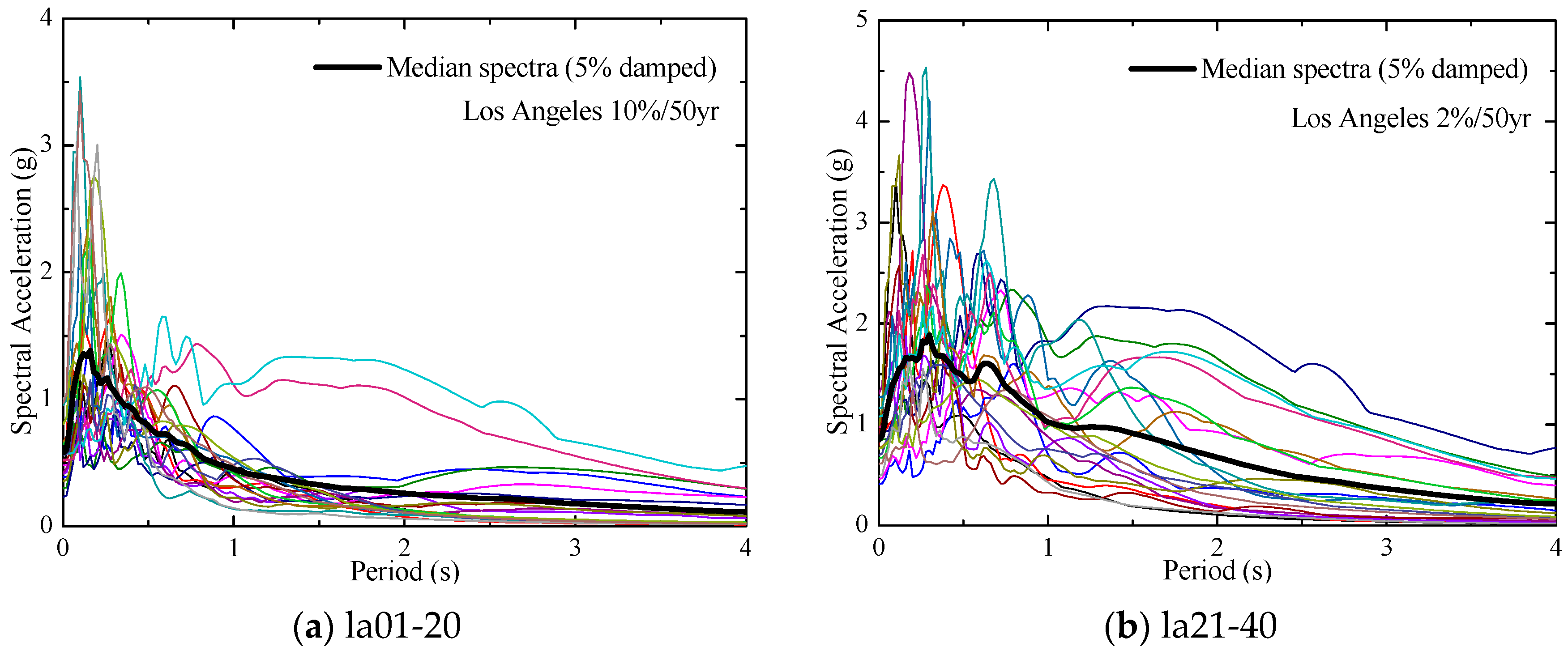

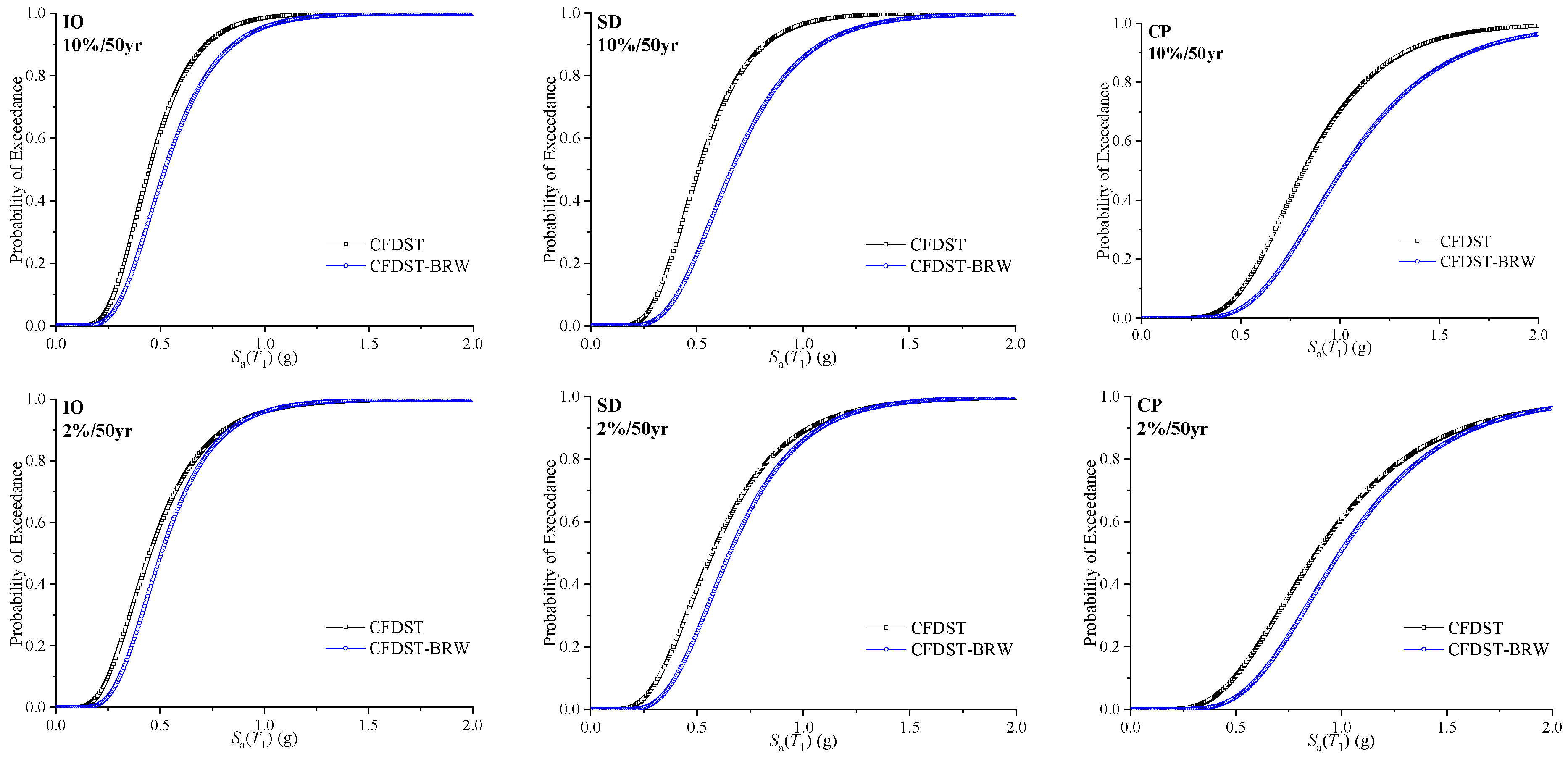

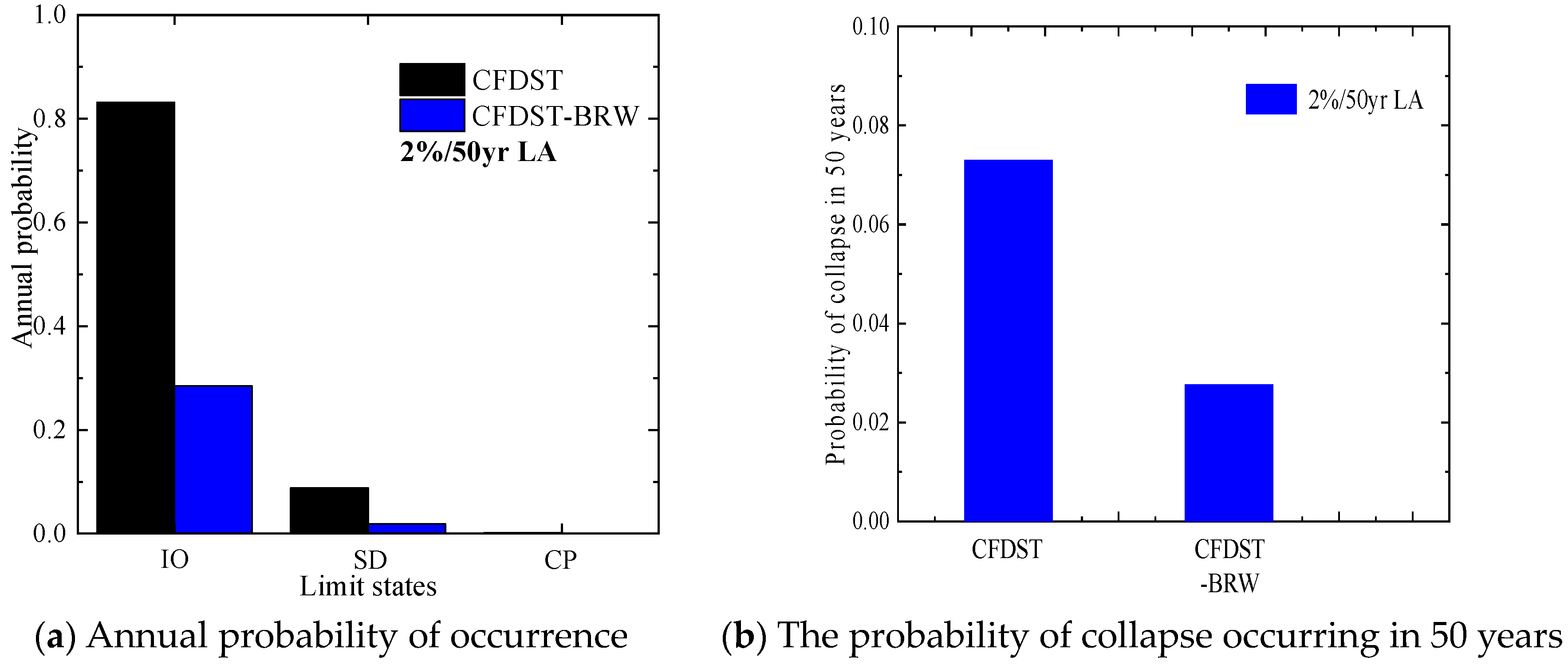
| Type | Size | T1 (s) |
|---|---|---|
| CFDST -BRW | The thickness of reinforced concrete is 120 mm, and the spacing between steel bars is 206.130 mm. It is distributed in two layers along the thickness direction of the plate. The diameter of the steel bars is 10 mm. The thickness of the protective layer is 20 mm | 1.415 |
| Model | Earthquake Grouping | mIO | mSD | mCP | βR |
|---|---|---|---|---|---|
| CFDST-BRW | 10%/50 year | 0.224 | 0.390 | 1.021 | 0.382 |
| 2%/50 year | 0.208 | 0.377 | 0.983 | 0.391 |
| Model | T1 | Sa (T1) (g) | k | k0 (×10−4) | |
|---|---|---|---|---|---|
| 10%/50 year | 2%/50 year | ||||
| CFDST-BRW | 1.415 | 0.522 | 0.785 | 4.051 | 1.489 |
| Structural Model | Seismic Category | P [LSi] (×10−3) | ||
|---|---|---|---|---|
| IO | SD | CP | ||
| CFDST-BRW | 10%/50 year | 211.37 | 22.36 | 0.45 |
| 2%/50 year | 302.14 | 27.16 | 0.56 | |
Disclaimer/Publisher’s Note: The statements, opinions and data contained in all publications are solely those of the individual author(s) and contributor(s) and not of MDPI and/or the editor(s). MDPI and/or the editor(s) disclaim responsibility for any injury to people or property resulting from any ideas, methods, instructions or products referred to in the content. |
© 2023 by the authors. Licensee MDPI, Basel, Switzerland. This article is an open access article distributed under the terms and conditions of the Creative Commons Attribution (CC BY) license (https://creativecommons.org/licenses/by/4.0/).
Share and Cite
Sun, H.; Hu, Y.; Zhao, J.; Wang, D.; Liu, Y. A Seismic Risk Assessment of Concrete-Filled Double-Skin Steel Tube (CFDST) Frames with a Beam-Only-Connection for Reinforced Concrete Shear Walls (BRWs). Buildings 2023, 13, 2378. https://doi.org/10.3390/buildings13092378
Sun H, Hu Y, Zhao J, Wang D, Liu Y. A Seismic Risk Assessment of Concrete-Filled Double-Skin Steel Tube (CFDST) Frames with a Beam-Only-Connection for Reinforced Concrete Shear Walls (BRWs). Buildings. 2023; 13(9):2378. https://doi.org/10.3390/buildings13092378
Chicago/Turabian StyleSun, Hongyu, Yi Hu, Junhai Zhao, Da Wang, and Yi Liu. 2023. "A Seismic Risk Assessment of Concrete-Filled Double-Skin Steel Tube (CFDST) Frames with a Beam-Only-Connection for Reinforced Concrete Shear Walls (BRWs)" Buildings 13, no. 9: 2378. https://doi.org/10.3390/buildings13092378





